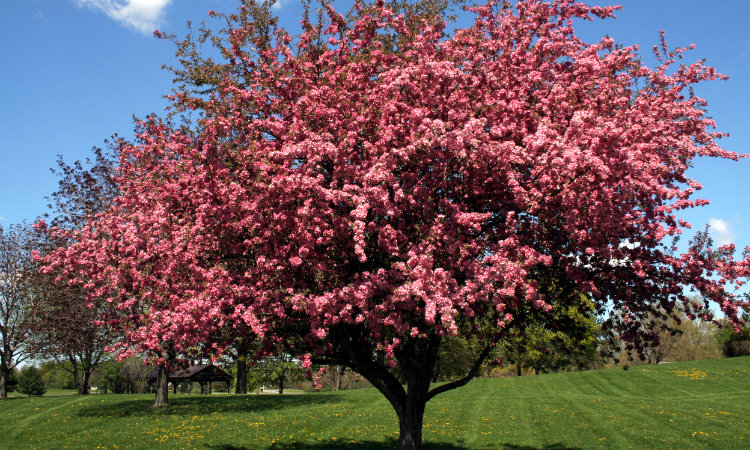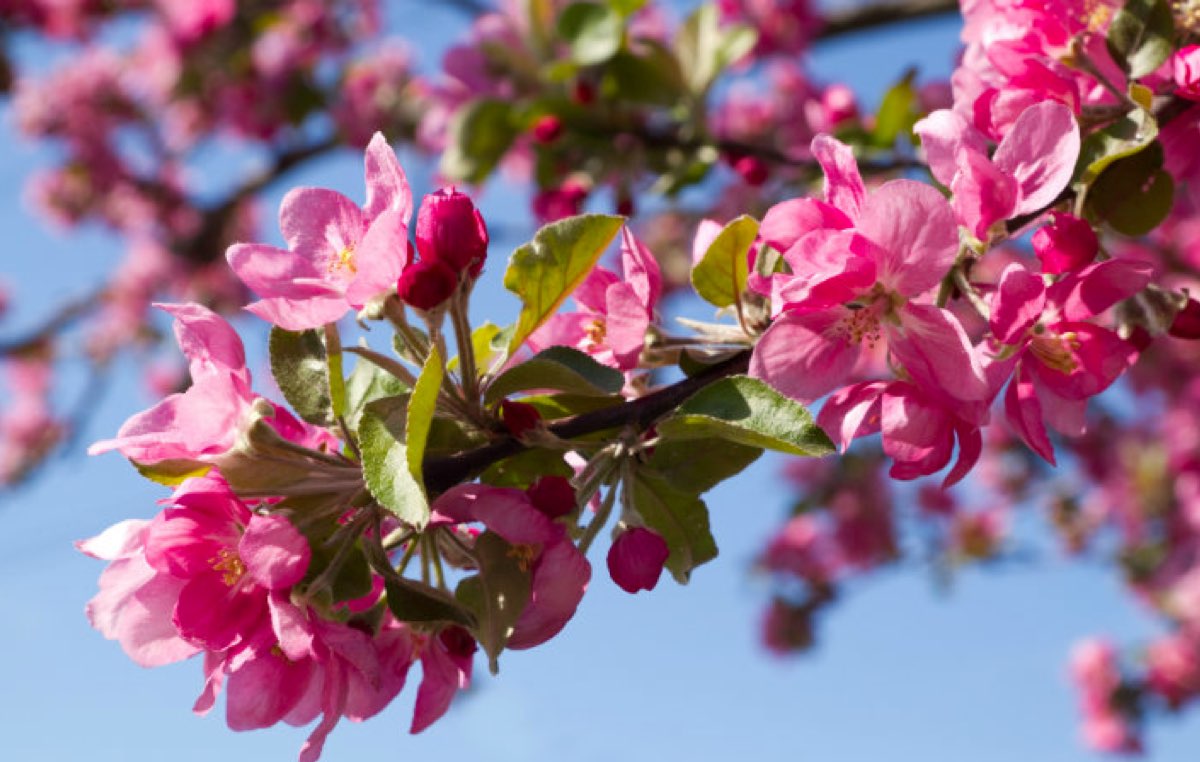Spring is like a rebirth after a cold and dormant winter, when fresh blooms, warmer weather and newly emerging wildlife heralds the start of a beautiful new season.
Brightly coloured, fragrant flowers bring joy to the garden, parklands and countryside at this time of year, from the sunny yellow trumpets of daffodils to the rainbow of anemones adding a splash of colour to backyard beds.
Japanese Crab Apple
Malus floribunda

This striking ornamental tree really comes into its own in spring when it puts on an impressive floral display. Delicate white and pink blooms and rosy edible fruits drip from every branch of this easy-to-grow Japanese native as the weather heats up. The small, hardy tree can tolerate growing in a wide range of conditions in Queensland, South Australia and Western Australia. With a broadly domed crown and abundance of buds, this tree promises to be a focal point of the season.
Iris
Iris croatica

Comprising of over 300 species of bulbous perennials, the iris is a genus of the Iridaceae family of flowering plants that have been inspiring artists for centuries. Greek for rainbow, irises bring a welcome splash of colour in spring, widely distributed throughout temperate regions. Its showy flowers usually appear in deep shades of purple and blue with a striking yellow centre. Bearded varieties, recognisable for their three upright petals, come in a vast paint palette of colours and are easy to grow in full sunlight in moist, well-drained soil. Flowers have six petals, which may be bearded, beardless or crested, that come into bloom from later winter through to the end of summer.
Freesia
Freesia

This cheerful spring-flowering bulb grows in a variety of vibrant colours from pinks and yellows to reds and purples, emitting a beautifully sweet fragrance that makes it a garden favourite. Easy to grow with very little maintenance once established, freesias are ideal for adding to rockeries and pots for a scented spring garden. Freesia’s upward-facing flowers are what’s known as ‘zygomorphic’, which means they have only one plane of symmetry, and they make a wonderful cut flower for inside. Found growing wild in South Africa, they are surprisingly well suited to growing in Australian conditions, ideally suited to a well-drained spot in full sun or light shade.
Hyacinth
Hyacinthus

Tight clusters of perfumed blooms grow around a central flower spike that makes hyacinths an unmistakable spring perennial. The short-lived wands of pastel colours emit an intoxicatingly sweet scent for two to three weeks at a time, best planted en masse in beds for a real feature display, though they’ll also grow quite happily in pots. Part of the lily family - look closely and you’ll see the familiar tubular shaped flowerheads - the upright stems and succulent leaves work especially well in formal flower gardens.
Granny’s bonnets
Aquilegia

Bridging the gap between spring and summer, these striking bell-shaped blooms, also known as columbines, are a great in-between flower that will open up for a display of colour at the end of spring. Part of the buttercup family, resplendent shades of pink, purple and gold burst forth from long stems emerging above feathery fern-like foliage. Aquilegia, roughly translating to bird, resembles the outspread wings of a bird with its decorative petals and arched spurs like an eagle’s talons. Popular with birds, bees and gardeners alike, most varieties will flower for at least four weeks, seeding and returning to your garden year after year. Hardy and adaptable, well suited to cooler climates, Granny’s Bonnets are ideal for planting in borders and rockeries and make excellent cut flowers.
Anemone
Anemone

If you want a carpet of colour to fill the gaps in your planting, then anemones are the flowers for you. The sweet, delicate blooms are grown for their variety of colours, sizes and bloom times, flowering in spring, summer and autumn. The attractive perennials, also known as windflowers, don’t require much maintenance once established, in fact, they’re very forgiving; happy to grow in moist, well-drained soil in partial shade. The poppy-like flowerheads sit atop upright stems and blossom in almost every hue, ideal for planting as a mass display in garden beds and borders.
Daffodil
Narcissus

Possibly the most iconic and easily recognisable spring flower is the daffodil. Ideally suited to the cooler climes of southern Australia, their sunny yellow and orange blooms truly herald the start of spring. Laid back and easy to grow in full sun or partial shade with next to no maintenance, daffodils grow quite happily under deciduous trees, multiplying to grow year after year. The hardy perennials bear six petals with a trumpet-shaped central corona, suitable for planting between shrubs, in borders and in beds. Daffodils also make beautiful long-lived cut flowers for an indoor spring bouquet.
Wallflowers
Erysimum
A member of the mustard family, wallflowers boast a beautifully sweet clove scent and range from dwarf flowers to medium-sized shrubs that are mainly evergreen. Lending themselves well to growing in sunny borders and rockeries, the plants have striking blue-green narrow leaves and spring flower stems that bear buttery yellow to soft apricot-coloured heads attracting pollinators and many other beneficial insects. There is a range of ornamental multicoloured species to grow too, that change colour with age, flowering from autumn through to summer.
Snapdragon
Antirrhinum
Blooming in September, snapdragons provide a pop of colour at the start of spring, usually found in temperate regions of the Northern Hemisphere making them well-suited to growing in New South Wales’ coastal regions, Sydney and Victoria. The much-loved garden annuals are named after the flower’s unique dragon-like face shape with a ‘mouth’ that opens and closes when squeezed. Compact with long spike-like stalks, snapdragons are ideally suited to sunny garden beds. Its flowers spiral around tall stems, blooming in vibrant pinks, mauves, yellows and snowy whites providing a rich source of nectar for visiting bees and birds.
Himalayan Blue Poppy
Meconopsis betonicifolia

If you’re up for a challenge, then there really is no greater reward than this stunning blue bloom from Tibet, one of very few true-blue flowers available to grow. Emerging in late spring, the poppy’s four electric blue petals are a sight to behold, ideally suited to cool climate gardens in the southern half of Australia. The plant grows best in full or dappled shade in moist soil with a layer of mulch, but be warned, it can be a very fussy flower that requires careful soil preparation, regular watering with a Soaker Hose and the right position to truly thrive. This species is best suited to mass planting.










